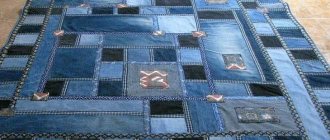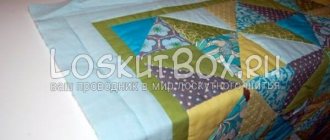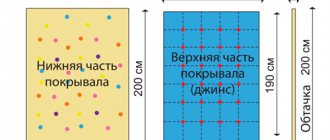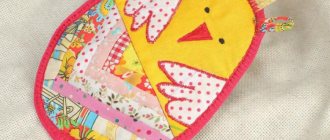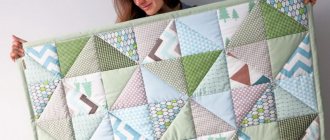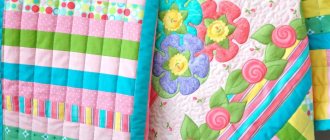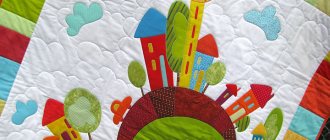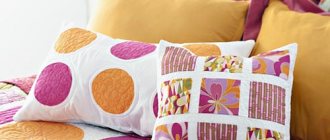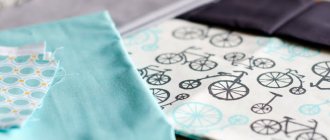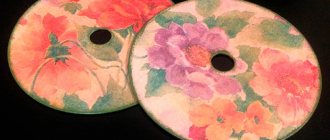Have you been looking in stores for a long time at beautiful samples of bedspreads made from scraps of fabric of various colors and patterns , but was the price too high?
Do you love to sew, but have a lot of leftover fabrics of different colors accumulated at home?
Then you can make your dream of a beautiful patchwork quilt come true with your own hands. patchwork will help you with this .
Patchwork video lessons different techniques
Taking advantage of the opportunities provided by patchwork, quilt, chenille, shoil, yo-yo and other popular patchwork techniques, you can create original and practical products for the home with your own hands from leftover fabric - blankets, pillows, curtains, tablecloths, rugs, panels, and also clothes, bags, cosmetic bags, notebook covers, toys and much more.
Patchwork Quilt
The patchwork fashion has revived the popularity of patchwork quilts in today's world. The history of their appearance is associated with a lack of funds to purchase expensive products, as well as a shortage of fabrics. In addition, the patchwork quilt had a sacred character, acting as a talisman and a symbol of the connection between generations within the family. Not without reason, patchwork quilts were a mandatory wedding gift for newlyweds or a dowry for a newborn baby. Traditionally, brightly colored chintz was used to make it, so the blanket had not only a practical function, but also an aesthetic one, decorating the home.
The warmth and comfort that patchwork style blankets provide has ensured their popularity in the present day. When sewing them, they still use natural cotton fabrics: chintz, calico, calico, flannel, flannel. Only the filling has changed; now modern materials are used to make blankets: padding polyester, Thinsulate, batting, Isosoft, holofiber, etc.When sewing blankets in patchwork style, simple assembly patterns are used. Individual elements are mainly cut out in the form of squares, which are connected to each other in any order. This simplicity is explained by the fact that clothes are most often used tucked into a duvet cover, so there is no need for particularly complex patterns. Stitching remains an essential element of a patchwork blanket. Figured or simple, it connects 3 layers - the top patchwork, the middle one consisting of insulation and the bottom one - a lining. Quilting can be done by hand using a buttonhole stitch, hand stitching or a goat stitch. But most often, quilting has recently been performed on a sewing machine, using a figured or simple stitch along the contour.
Patchwork bedspread
A bedspread, unlike a blanket, is thinner and has greater functionality. It is used as a blanket to cover or wrap up while sitting in a chair or on a sofa, and also as a cape to cover bedding or upholstery. Like a blanket, it consists of 3 layers, only instead of bulky insulating pads when sewing bedspreads, non-woven fabric or thin padding polyester is used, which does not create a large volume. For the details of the top, when sewing it, denser materials are used - linen, jacquard, tapestry, mixed fabrics. Since the bedspread often plays an aesthetic role in the interior, more complex and interesting patterns and designs are chosen for sewing it.
Types of fabrics
- The most common type of fabric is cotton. A cotton patchwork blanket has the following advantages: medium density, light and tactilely pleasant, does not shrink when washed, does not cause allergic reactions because it is a natural fabric, is easy to stitch, and the material does not fray.
- Linen is also a natural fabric, but craftsmen don’t really like to use it because it wrinkles easily. But the material is soft and pleasant to the body, and at the same time holds its shape well in the finished product, therefore, although not often, it is used to create blankets.
- Denim is an original and attractive material for patchwork techniques. All kinds of shades of blue allow the master to use them creatively and to fantasize about the arrangement of the patches. You can also decorate jeans with some details if you want to dilute the blue, for example, with metallic elements.
- Viscose is also a great material because it is pliable and soft. But there is one caveat - viscose is difficult to combine with other fabrics due to its weak stretch; less elastic fabrics will not work. Therefore, for patchwork, viscose is used as the only type of fabric - the blanket will be very soft and pleasant.
- Silk or drape is also often used.
- Insulated material, like wool, can also be the basis for blankets and blankets. The fabric is natural, usually dried wool is used.
There are fabrics that are used to a lesser extent because they are too elastic. These are corrugated and pleated, thick coat materials, fur, fabrics with metallized threads.
Patchwork patchwork patterns
Experts recommend mastering the patchwork technique by creating a large product - a blanket or bedspread. You can assemble patchwork elements into a whole product at will, improvising along the way, but products where patches sewn together form a certain pattern or color gradation look much more interesting. To do this, a sketch or diagram is created in advance, where all the elements are drawn in detail. Then individual parts are prepared, which are assembled in accordance with the diagram, first into blocks, and then individual blocks into a single sheet, which is connected to the lining. For convenience, when cutting flaps, cardboard or plastic templates are used, which make it easy to cut the required number of parts of the same size.
Selection of parts by color
Color selection is a very important stage in the patchwork technique. If the colors do not harmonize or have high contrast, then the eyes will get tired, and such a product will not suit the interior of the house.
Pillow and blanket design
You must follow the instructions for combining shades. Beginning craftswomen can use the technique of three colors and three patterns. In this case, contrasting shades maintain dynamics if the main canvas is not chosen in a bright color.
Requirements when choosing a pattern:
- to begin with, you can make a product template to have a visual idea of the future work;
- there should not be too small and bright patterns, otherwise the eyes will start to ripple;
- for a complex design, it is advisable to experiment through shades rather than through the design of small elements;
- It is advisable to choose large drawings of a bright monochromatic shade rather than many small ones with their own pattern;
- Place the scraps on the floor and stand back to make sure the colors are correct.
Idea for coloring a patchwork bedspread
Also, if this process is difficult for a person, then you can use a special program on the Internet. It automatically selects colors that go well together. Below is a detailed description of how to sew a patchwork quilt.
Patchwork and patchwork techniques
Patchwork is the most popular patchwork technique, which involves creating a whole product by sewing together individual patches. Working in this technique, you can master several types of patchwork:
- classic or English involves assembling a whole product from scraps of the same size and shape - square, triangle, rhombus, rectangle, hexagon, etc.;
- crazy is a type of patchwork in which products are created from scraps of various colors, sizes and shapes, sewn randomly. The seams of such products are additionally decorated with ribbons, lace, and the products themselves are decorated with beads and seed beads;
- Japanese patchwork - a technology for creating floral and geometric patterns from silk rags using sashiko stitches;
- knitted patchwork involves creating a product from scraps of knitted fabric, knitted or crocheted elements;
- quilting or quilted fabric consists of 3 layers - the top or decorative layer, assembled from individual elements or consisting of a single piece, the middle layer is a soft cushioning material - batting, holofiber or padding polyester and the bottom layer is a base or lining consisting of a single piece of fabric . All layers are quilted together by hand or by machine; the top layer can additionally be decorated with braid, appliqué, and cords.
When creating products in the patchwork style, various techniques are used.
Those who are just starting to master this type of needlework should try the following techniques:
- squares - a method that assumes that the entire product consists of identical square or rectangular elements assembled into large square blocks;
- stripes - a method of assembling rectangular elements of various sizes in a spiral, parallel, zigzag, ladder, etc.;
- triangles - a method that uses triangular-shaped parts assembled into strips, squares or star-shaped blocks;
- honeycomb - this technique is used when assembling hexagonal parts.
Having mastered the assembly of simple geometric elements, you can move on to more complex patchwork techniques - lapachika, chenille, watercolor, yo-yo, shoil, English park, rag quilt, bargello, patchwork corners, boro, frayed quilt, Australian stained glass, etc.
Creation technique
The easiest way to work is to sew a product using the patchwork technique from identical pieces of squares. In this case, the work process will be very easy, and will be suitable for beginning needlewomen.
How to sew a patchwork quilt with your own hands, step-by-step instructions:
Machine stitching process
- It is necessary to cut out as many identical squares as possible from the pieces - it is advisable to use a centimeter to get the exact dimensions;
- Working on a typewriter will save a lot of time, but doing it manually is also possible quite quickly. Sew the squares in rows, and then sew the rows themselves. When the product is ready, it must be ironed from the wrong side to smooth out the seams;
- Next, you need to measure the bedspread in order to make the inner lining. You need to attach the blanket to the lining material with the front part facing up;
- Next, you need to also cut out a square from denim or any other material - this will be the inside of the blanket. Now place the denim with the right side on the stack of lining and blanket;
- it is necessary to flash this stack. You need to remember that a hole is left in the bedspread so that you can turn it inside out later;
- if the work is done correctly, then on one part there will be denim material, on the other there will be the outer side of a blanket made of pieces, and inside there will be a lining;
- sew up the hole with a hidden seam and iron the finished product well.
You might be interested in Features of the chenille technique: details for beginners in sewing
Scheme of stripes
The blanket is ready, now you need to wash and iron it.
The size of the product is selected depending on the desires of the person; it is mainly made for a double bed. You can use jeans or fleece as a lining. Below is a patchwork bedspread that is beautiful and easy for beginners.
DIY patchwork bedspread
A beautiful, bright bedspread measuring 140x110 cm, sewn from squares of the same size, can be made even by those who are just trying their hand at patchwork, the main thing is to know how to use a sewing machine. Work begins with developing a sketch and procuring the necessary materials. As a pattern diagram for the future blanket, you can use the examples presented in this article or come up with your own.
To work you will need:
- cotton fabric of various colors, which must be cut into identical squares measuring 16x16 cm, 63 squares in total;
- a piece of padding polyester measuring 115×145 cm;
- a piece of cotton fabric for lining measuring 120x150 cm;
- bias binding 4.1 m;
- cardboard template;
- scissors, thread, pins, chalk;
- sewing machine;
- iron.
1. Before cutting, the fabric should be washed and ironed to prevent it from shrinking later. Since precision cutting is the key to a neat product, you should use a cardboard template when cutting individual elements. Using it, I cut out 63 square blanks 16x16 cm (taking into account the allowance, in finished form - 15x15 cm).
2. Place squares on the table, 7 pieces in each row (9 rows) in accordance with the selected pattern.
3. Sew individual elements, folding them face to face, using a machine into strips of 7 squares. Iron seam allowances to one side.
4. Sew the collected strips into a single fabric, iron the seams.
5. Place the lining piece face down on the table, place padding polyester or other insulation on top of it, and cover it with a patchwork fabric so that it faces up. Pin the product together at the corners of the squares in each row.
6. Quilt the blanket lengthwise and crosswise on a machine, placing stitches in the seams connecting the squares, or parallel to them. Remove the pins and sew along the edge of the product.
7. Cut off the excess padding along the edge of the product, and then process the cuts with bias tape. To do this, fold a short section of the bias tape, place it on the lining side of the blanket and stitch along the stitching of the edges of the blanket. Not reaching 0.5 cm to the end, interrupt the stitching and, turning the product, start a new stitch from the corner, placing a corner of the bias tape in the fold. Having sewn it along the entire perimeter of the blanket, turn the binding onto its front side, straighten the corners. Fold up a long section of the binding and stitch it onto the front side of the blanket. The blanket is ready.
You can watch the video in more detail about the process of sewing a patchwork quilt.
Patchwork with knitting needles: a plaid knitted with simple squares from the corner
Bright plaid made from squares knitted from the corner
The most common method of creating a patchwork style bedspread with knitting needles is the so-called garter knitting. It is a combination of knit stitches and decreases. The process goes as follows.
- Cast on an odd number of stitches for the base
Their exact number depends on the size of the square. And equal to the sum of the loops horizontally and vertically, plus one corner loop.
- Knit the motif with knit stitches
In the process, on every second row, decrease three loops in the middle.
- Form the outer edge of the motif using knots
That is, always removing the first stitch of the row without knitting it.
- Complete the square
When, as a result of constantly decreasing, only one loop remains in the row, cut and fasten the thread.
- Start the next tune
The basis for it will be one of the sides of an already knitted fragment and a number of cast-on loops.
Thus, step by step, a whole fabric of yarn is created. It is important not to change the direction of knitting during the process, so that the protruding convex diagonals on the front side of the blanket, resulting in the process, are directed in the same direction.
Patchwork crochet patchwork knitting
Crochet patchwork provides great opportunities for creativity. Using this technique, you can make a variety of products for the home, toys, clothes, and accessories. When creating individual elements, traditional crochet techniques are used - granny square, fillet technique, triangular, round and hexagonal openwork motifs and dense patterns. The individual elements are connected to each other using a hook into larger parts. When knitting blankets and rugs, finished knitted fabrics can be placed on a lining or used without a lining. Along the perimeter, such products can be decorated with a knitted border or scallops. Products that combine several crocheting techniques, as well as crocheting and knitting, or assembled from knitted and textile parts will look interesting.Blanket made of squares knitted in a spiral
This type of patchwork with knitting needles is very similar to the previous technique in execution. The creation of this motif also begins with knitting a chain of air loops - however, in this case there should be eight of them. Then the loops are closed in the same way into a ring and distributed along the knitting needles, forming the edges of a square.
After this, the element is knitted with a facial pattern; each subsequent row must be started with a yarn over, thereby increasing the number of loops. You should continue knitting until the fragment reaches the desired size.
The element thus obtained has on its front surface convex spiral arcs diverging from the center in four directions. Visually it looks quite interesting.
Patchwork pillows patchwork pattern, do it yourself
Decorative pillows are a great opportunity to add some zest to the interior of your living room or bedroom. When doing it in patchwork style, you can choose not only simple natural fabrics, but also those containing mixed fibers or those with a rich texture.
To sew a pillow 36×436 cm in patchwork style you will need:- several scraps of fabric, harmoniously combined with each other;
- piece of fabric for the back of the pillow 40x40 cm;
- a piece of non-woven fabric 40×40 cm;
- pillow filling;
- zipper 20 cm long;
- threads, pins, scissors;
- sewing machine and iron.
Pre-wash and iron the fabric.
- Cut 9 squares measuring 11x11 cm, 5 heart-shaped pieces of smaller size, 4 strips 30x8 cm and 4 squares 8x8 cm.
- For 5 squares measuring 11x11 cm, cut a heart-shaped notch, 1 cm smaller than the heart-shaped pieces.
- Cut 4 squares measuring 11x11 cm diagonally into 2 triangles, and then cut each triangle again, so from 1 square you get 4 triangular elements.
- Lay out the parts on the table to create a pillow pattern, as shown in the diagram below (Fig. 1).
- Sew square blanks from triangles (Fig. 2 and 3), seam width 1 cm.
- Sew the details of the hearts into the squares with the corresponding notches (Fig. 4,5), iron the seams.
- Sew the square blanks into strips of 3 pieces, observing the sequence of the pattern, iron the seams.
- Sew the strips together into a whole fabric in accordance with the diagram, iron the seams.
- Sew previously cut strips of fabric along the perimeter of the assembled fabric and sew square elements measuring 8x8 cm into the corners. Iron the seams to one side (Fig. 6). Glue the entire part from the inside with non-woven fabric.
- Cut the piece of flap for the wrong side of the pillow into 2 parts. Stitch them together along the edges, leaving a hole for the zipper - 20 cm. Sew in the zipper (Fig. 7).
- Fold the front and back pieces of the pillow with the right sides facing in, pin together and stitch around the perimeter.
- Turn the pillowcase right side out and place it on a ready-made sofa cushion of a suitable size or fill it with padding polyester or holofiber.
[yframeurl='
https://youtu.be/QItfJeRWwwM
']
How to knit a traditional granny square
This type of pattern combines simplicity and aesthetic appeal. For this reason, this knitting is very common. But with the help of original color schemes and well-chosen yarn, it can be transformed and made to sparkle with new colors.
To connect crocheted parts, you can use a diagram
It is knitted from the center, according to the following pattern:
- From the starting loop, make three double crochets;
- tie two air loops;
- followed by three more similar columns from the initial loop, two air loops;
- repeat this algorithm two more times;
- close the circle with a single crochet;
We knit loops in a circle according to the pattern 4 times - 3 double crochets, 2 chain loops, connect - tie the second row with the same groups of double crochets, three each from the chain stitches of the previous row;
Create the 2nd row, marking the corners of the motif - in the classic version of this pattern there are only four rows, but it is permissible to increase this number to five, six, seven and so on.
We make blanks of different sizes from two, four, six, eight and ten rows
Patterns of knitted squares for beautiful and original bedspreads
By moving the middle of the “grandmother’s square” to the edge, you can give this traditional pattern asymmetry and originality.
Scheme of the granny square pattern for knitting from the corner
Square motif of “granny square” associated with corner
After the parts are ready, carefully sew the parts together
Combining different colors, we get an incredibly beautiful bedspread
Patchwork patchwork bags
A bag is a must-have element of any woman's wardrobe. Having mastered the technique of patchwork, you can create original designer accessories yourself. To sew patchwork style bags yourself, it is recommended to choose durable, wear-resistant fabrics.
Patchwork quilting
Quilting is a type of patchwork. Its characteristic feature is the figured stitch. Products made in the quilting manner - quilts - are often complemented with embroidery, appliqué, and decorated with beads, buttons, and ribbons. Inspired by the ideas below, you can sew your own quilt by hand or on a sewing machine.
Patchwork paintings and panels
The possibilities of quilting as a type of needlework are enormous. Experienced craftswomen use this technique to create real paintings from fabric.
Patchwork patterns templates
Using the presented diagrams, it will not be difficult to sew a product yourself using the patchwork technique.
A simple and stylish pattern: a blanket knitted in reverse rows
Unusual blanket knitted in reverse rows
This technique begins with the usual “granny square” from the center. However, after the standard three or four rows in a circle, differences appear. Taking the bottom and left edge of the workpiece as a basis, form one row of single crochets, two with a double crochet and one final row of single crochets. Then repeat the same sequence of actions, starting from the top and right edge of the figure.
You can act according to this scheme, periodically changing colors until the final dimensions of the product suit you.

